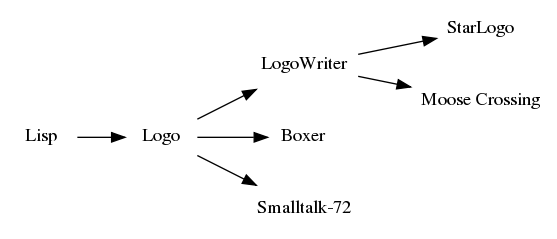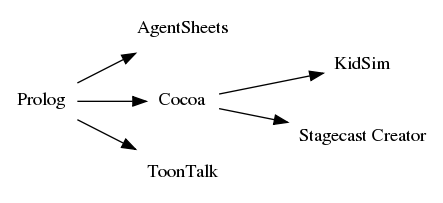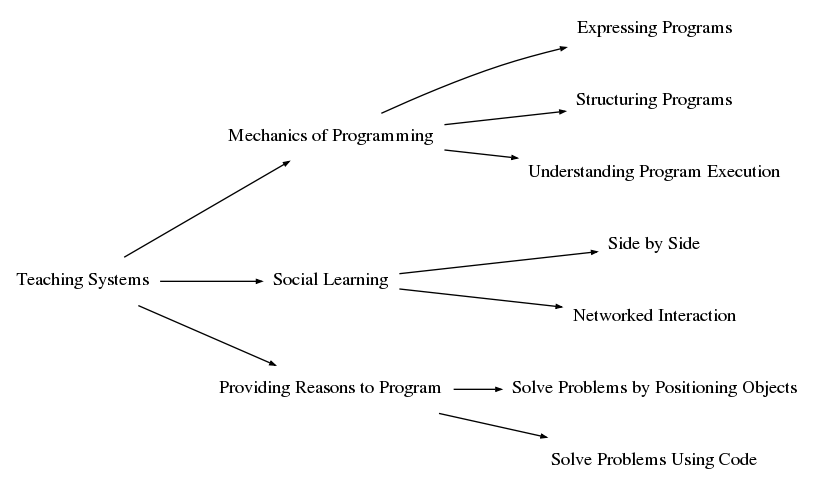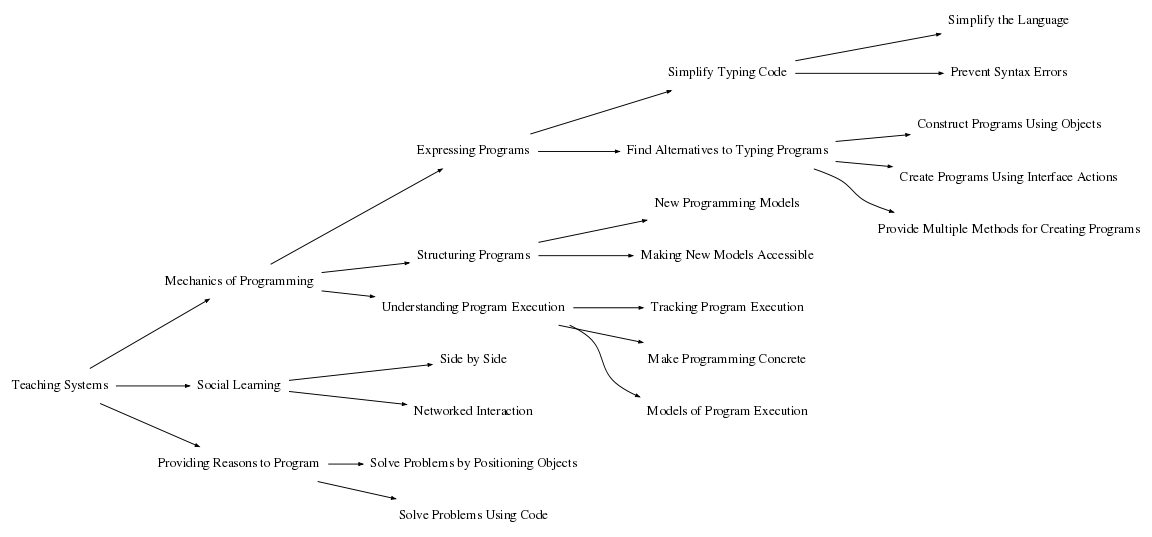Taxonomy of programming environments for novices
(→????) |
(→Next step) |
||
| Строка 170: | Строка 170: | ||
node [nodesep=2, shape="none", style=""] ; | node [nodesep=2, shape="none", style=""] ; | ||
| + | edge [arrowhead=normal, arrowsize=0.4, len=1.2]; | ||
| + | |||
| + | size ="12,12" ; | ||
| + | |||
| + | rankdir=LR ; | ||
| + | |||
| + | |||
| + | "Teaching Systems" -> {"Mechanics of Programming", "Social Learning", "Providing Reasons to Program" } ; | ||
| + | |||
| + | |||
| + | "Mechanics of Programming" -> "Expressing Programs" ; | ||
| + | "Mechanics of Programming" -> "Structuring Programs" ; | ||
| + | "Mechanics of Programming" -> "Understanding Program Execution" ; | ||
| + | |||
| + | "Social Learning" -> "Side by Side"; | ||
| + | "Social Learning" -> "Networked Interaction"; | ||
| + | |||
| + | "Expressing Programs" -> "Simplify Typing Code"; | ||
| + | "Expressing Programs" -> "Find Alternatives to Typing Programs" ; | ||
| + | |||
| + | "Structuring Programs" -> "New Programming Models" ; | ||
| + | "Structuring Programs" -> "Making New Models Accessible" ; | ||
| + | |||
| + | "Understanding Program Execution" -> "Tracking Program Execution"; | ||
| + | "Understanding Program Execution" -> "Make Programming Concrete"; | ||
| + | "Understanding Program Execution" -> "Models of Program Execution"; | ||
| + | |||
| + | |||
| + | "Providing Reasons to Program" -> "Solve Problems by Positioning Objects" ; | ||
| + | "Providing Reasons to Program" -> "Solve Problems Using Code" ; | ||
| + | |||
| + | "Simplify Typing Code" -> "Simplify the Language"; | ||
| + | "Simplify Typing Code" -> "Prevent Syntax Errors"; | ||
| + | |||
| + | "Find Alternatives to Typing Programs" -> "Construct Programs Using Objects" ; | ||
| + | "Find Alternatives to Typing Programs" -> "Create Programs Using Interface Actions" ; | ||
| + | "Find Alternatives to Typing Programs" -> "Provide Multiple Methods for Creating Programs" ; | ||
| + | |||
| + | } | ||
| + | |||
| + | </graphviz> | ||
| + | |||
| + | === Next step === | ||
| + | |||
| + | <graphviz> | ||
| + | digraph L11 { | ||
| + | |||
| + | node [nodesep=2, shape="none", style=""] ; | ||
| + | |||
edge [arrowhead=normal, arrowsize=0.4, len=1.2]; | edge [arrowhead=normal, arrowsize=0.4, len=1.2]; | ||
Версия 16:26, 19 августа 2018
Different types of Taxonmy:
- Five levels
- What makes programming hard?
- Clusters
Содержание |
Five levels
Initial Learning Environments
- Level 0
- Age range 2-7 years. Drag-and-Drop or simpler. Teaches planning (sequence) only. Requires no abstraction. Contains no significant use of: functions, variables, iteration, indexed data structures, conditional execution.
- Examples: Daisy the Dinosaur, LightbotJR, ScratchJR, Pictomir
- Level 1
- Age range 5-10 years. Drag-and-Drop. Requires no abstraction (or small amounts). Contains none or few of: functions, variables, iteration, indexed data structures, conditional execution.
- Examples: ScratchJR, Pictomir, Lightbot, Kodu, Blockly, Hopscotch, Scratch, Tynker
- Level 2
- Age range 8-14 years. Drag-and-Drop or textbased. Includes some abstraction. Contains some or most of: functions, variables, iteration, indexed data structures, conditional execution.
- Examples: Kodu, Blockly, Hopscotch, Scratch, Tynker, NetLogo, Alice, AppInventor, Looking Glass, Snap!
- Level 3
- Ages 12 years and up. Drag-and-Drop or textbased. Includes abstraction. Contains all of: functions, variables, iteration, indexed data structures, conditional execution.
- Examples: Scratch, Tynker, NetLogo, StarLogo Nova, Snap!, Alice, AppInventor, Looking Glass, StarLogo Nova, BlueJ, KidsRuby
- Level 4
- Ages 14 years and up. Teaches an industry-level. Turing-complete programming language. Advanced, with extensions available. Contains all of: functions, variables, iteration, indexed data structures, conditional execution.
- Examples: Squeak, Codecademy
What makes programming hard?
Mark Guzdial believes that each novice programming environment (or family of environments) is attempting to answer the question, "What makes programming hard?". In his article "Programming Environments for Novices" Guzdial focuses on three families that have been particularly influential in the development of modern environments:
- The Logo family of programming environments, that began as an off-shoot of the AI-programming language Lisp
- The rule-based family of programming environments, that drew from both Logo and Smalltalk-72, but even more directly, Prolog.
- The traditional programming language family of novice programming environments, which tried not to change the language, but instead provide new student-centered supports for existing programming languages.
Logo family
The answer to the question of "What makes programming hard?" for the Logo developers was another question. When Logo was first being developed, people didn't know that programming was going to be so hard for so many. Programming was still a curiosity, an activity practiced only by the few who had access to the still-rare machines. The Logo developers asked instead "Why should students program?"

The Logo family of novice programming environments
The rule-based family of programming environments
Another set of answers to the question "What makes programming hard?" includes "The interface" (as diSessa said) but also "The kind of programming" (as Kay said).

The rule-based family of programming environments
The traditional programming language family

Family of novice programming environments based on supporting traditional programming languages
Novice Programming Systems and Languages Taxonomy
- Lowering the Barriers to Programming
- a survey of programming environments and languages for novice programmers
- Caitlin Kelleher and Randy Pausch, 2005

Next step

Next step

TACCC 3
Template for a resource review
García-Peñalvo, F.J., 2016. Template for TACCLE 3 resources reviewing. DOI= http://dx.doi.org/https://dx.doi.org/10.6084/m9.figshare.3545033.v1.
Title: The resource title Description: A short, but significant resource description Link: Link to the resource if it is available License: What kind of licensing system the resource has, if available (e.g. if videos are considered rather than software) Languages: In which languages the resource is available Target groups: Which are the main target groups of this resource Known uses: Examples of the use of the resource, it they exist (including videos, text based descriptions, links, etc.) Pedagogical level: Resource pedagogical level TACCLE Classification: The classification of the resource taking into account TACCLE ontology (Algorithms, Using logic, Controlling things, Creating and Debugging) Quality: Perceived quality of the resource [scale 1-5] Open comments: Reviewer’s comments Date: Date of the review
Examples
- Title: Minetest
- Description: Minetest is a near-infinite-world block sandbox game and a game engine, inspired by InfiniMiner, Minecraft, and the like.
- Link: http://www.minetest.net/
- License: LGPL
- Languages: English
- Target groups: pre-university and university students
- Known uses: use as a game, use to solve and understand problems related to programming. Examples of its use in education: http://wiki.minetest.net/Mods:Learning; http://wiki.mcrcoderdojo.org.uk/index.php/MineTest
- Pedagogical level: Primary and Secondary students.
- TACCLE Classification: Using logic; Creating and Debugging
- Quality: 5
- Open comments: An open solution to use in education the potential of Minecraft.
- Date: August 6th, 2016
